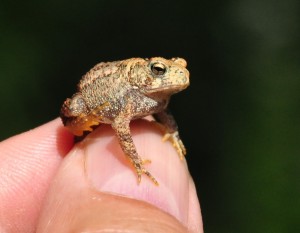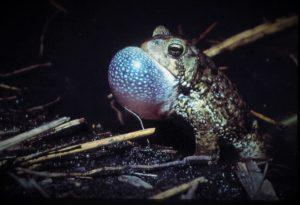Photography courtesy of Lowell Washburn, all rights reserved.
One thing that my Dad and I could always agree on was that neither one of us had ever landed a walleye while mowing the lawn. I am reminded of that depressing truth every time I crank up the mower and begin another mindless session of circling round and round the yard; engine roaring, blades whirling.
Although never a favorite pastime, I especially detest mowing during the month of August. That’s when the annual crop of newborn American toads makes their backyard appearance. I do the best I can with the situation. But although I stop and relocate every little hopper I see, I know that at least some of the little critters must be going under the blade.
The saga begins each year during late April when male toads begin gathering around the tiny pond located beside my driveway. Once assembled, the amphibians begin their distinctive spring trilling. It’s a unique vocalization that, once heard, easily distinguishes the toad from all other spring crooners. Highly competitive, the melodious repertoire is designed for the sole purpose of attracting members of the opposite sex. The more and louder each male sings the more likely his chance of attracting a mate. Unlike other spring callers [such as chorus frogs or spring peepers] American toads possess a unique ability to harmonize. Whenever a male bursts into song, nearby competitors quickly join in. The pitch perfect result becomes the outdoor equivalent of a Barber Shop Choir. For me, the only thing better than hearing one toad sing is hearing twenty.
Lured to the symphony, females soon began arriving at the pond. But the visits are short lived. After depositing their eggs into the warming water, they quickly return to wherever they were. With females gone, the males turn their thoughts to hunting nightcrawlers. Before long, the pond is silent. Eggs soon hatch; tadpoles grow and sprout legs. As the season finale, baby toads finally emerge. Once on land, many of those babies head for our lawn where they’ll consume insects for the remainder of the summer.
Toads are always welcome visitors. Their subtle coloring, sober posturing, and sparkling metal-flake eyes make them an interesting backyard addition. Perhaps more than anything, I admire toads for their amazing tactics for survival.
Protected by a pair of large, poisonous glands on their backs, toads get a free pass from would be predators. One notable exception is the garter snake which routinely adds toads to its menu. But obtaining the meal is not necessarily a slam dunk for the snake. Upon being ambushed and seized, the toad deploys an alternate defense system by quickly inflating its torso into a living balloon. The snake counters the move by attempting to puncture the toad’s skin with the needle-like teeth of its serrated jawline. If the skin pops, the toad deflates and becomes lunch. If the balloon holds, the suddenly too-large-to-swallow toad survives.
The dangers are endless. Toads making it past lawnmowers, garter snakes, and other summer hazards, will still need to survive the upcoming peril of an Iowa winter. Ever resourceful, the toad has a plan up its sleeve for that one too. At summer’s end, toads manufacture their own brand of antifreeze which keeps cells from bursting as they sleep through subzero temperatures buried deep into leaf litter or beneath the cover of rotting logs. Just one more incredible adaptation that makes the American toad an amazing resident of the Iowa outdoors.
Today is lawn mowing day. After exhausting every possible excuse, it’s time to crank up the grass cutter. It will likely be a lengthy session of starts and stops. Earlier this morning, I spotted four baby toads while walking just a few steps across the backyard. All things considered, I’d rather be fishing.




 Tom Cope
Tom Cope Sue Wilkinson
Sue Wilkinson Susan Judkins Josten
Susan Judkins Josten Rudi Roeslein
Rudi Roeslein Elyssa McFarland
Elyssa McFarland Mark Langgin
Mark Langgin Adam Janke
Adam Janke Joe Henry
Joe Henry Kristin Ashenbrenner
Kristin Ashenbrenner Joe Wilkinson
Joe Wilkinson Dr. Tammy Mildenstein
Dr. Tammy Mildenstein Sean McMahon
Sean McMahon